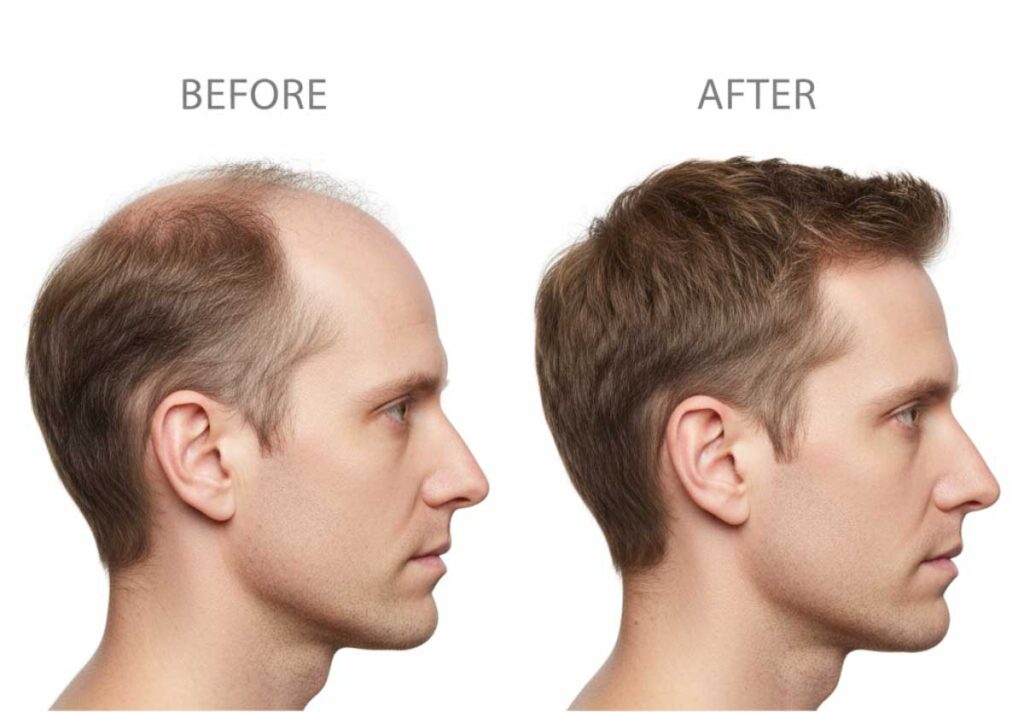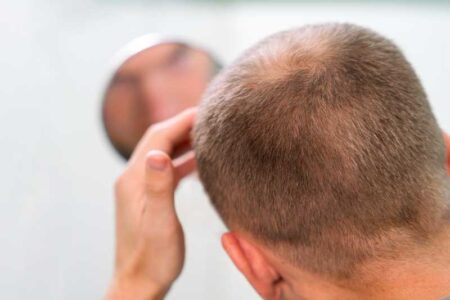Hair loss is a big problem for millions of men in the U.S. In 2025, new treatments for male pattern baldness are giving men hope. These treatments offer real results.
Thanks to medical progress, men can now tackle hair loss in new ways. Advanced technologies and methods help restore hair and confidence. This is a big change.
New treatments include medicines and surgery. Men can find solutions that fit their genetic makeup and hair loss patterns. This makes a big difference.
Genetic studies and new technologies have opened up new ways to restore hair. The latest treatments use advanced medical methods to grow hair follicles. This is a game-changer.
This guide will look at the best hair loss treatments for men in 2025. We’ll explore the latest and most effective ways to restore hair. These solutions are real and can change lives.
Understanding Male Pattern Baldness and Its Impact
Male pattern baldness is a common condition that affects millions of men. It starts with a receding hairline and thinning at the crown. Hormonal changes and genetics cause it, affecting a man’s confidence and mood.
Dihydrotestosterone (DHT) is a hormone that leads to hair loss. Men sensitive to DHT lose hair faster. Knowing how male pattern baldness works is key to finding treatments.
Hair loss affects men’s self-image. Many feel less attractive and less confident. It’s important to tackle hair loss early with effective treatments.
Genetics play a big role in male pattern baldness, with 80% of cases linked to family history. While genetics are important, modern treatments offer hope for managing hair loss.
Spotting early signs of male pattern baldness is crucial. Talking to a dermatologist or hair specialist can lead to male pattern baldness treatment options. These are based on your hair loss pattern and genetics.
Latest Innovations in Hair Loss Treatments for Men
The world of hair loss treatments for men has changed a lot in 2025. New solutions are here to fight male pattern baldness. These advanced technologies offer personalized care that goes beyond old methods, giving hope to men with hair loss.
Genetic screening is a big deal now. It lets doctors create treatment plans based on each person’s genes. This way, treatments can be made just for you, based on your hair loss.
Stem cell therapy is another big step forward. It lets doctors take and grow hair follicle stem cells. This means better and more natural-looking hair growth with less invasive procedures.
Nanotechnology is also making waves in hair restoration. It uses tiny systems to target hair follicles with great precision. This leads to better hair growth and fewer side effects than old treatments.
Artificial intelligence and machine learning are helping doctors too. They use big data to make treatment plans that are just right for you. This means better chances of success for hair restoration.
FDA-Approved Medications and Their Effectiveness
Choosing the right treatment for male pattern baldness can be tough. Two top FDA-approved options are finasteride and minoxidil. They are backed by science to help with hair thinning and growth.
Finasteride, known as Propecia, blocks DHT hormone production. It slows hair loss and may even grow new hair. Studies show about 65% of men see good results with regular use.
Minoxidil, sold as Rogaine, is applied to the scalp. It boosts blood flow to hair follicles, leading to thicker hair. Men often notice improvements in 3-6 months with regular use.
New research is bringing more treatments for hair loss. Doctors are working on better ways to fight hair loss. It’s important to talk to a doctor to find the best treatment for you.
Even though these treatments work well, everyone reacts differently. Side effects and health issues can affect what treatment is best for you.
Advanced Men’s Hair Restoration Solutions in 2025
The world of Hair Loss Treatments for Men has changed a lot in 2025. Now, there are new, effective ways to fight hair loss, including advanced men’s hair restoration solutions that are less invasive than before.
Stem cell therapies are a big leap forward in hair restoration. They use the body’s own healing powers to wake up hair follicles. This leads to new hair growth with less invasive procedures.
Platelet-Rich Plasma (PRP) treatments have also gotten better. New methods target hair follicles more accurately. This makes these treatments more effective at growing hair.
Low-level laser therapy is another big step. It uses light to boost hair growth and improve blood flow. Now, there are devices and treatments that are easy to use and backed by science.
Even with these new technologies, it’s important to have realistic hopes. Talk to hair restoration experts to find the best treatment for you.
Natural and Alternative Treatment Options
Men looking for hair loss treatments have many natural options. Herbal supplements like saw palmetto and biotin are popular. They may slow hair loss and improve hair health.
Scalp micropigmentation is a new way to deal with thinning hair. It’s a non-surgical method that makes hair look fuller. Many men find it a good choice without the need for surgery.
Changing your lifestyle can also help with hair loss. Reducing stress, eating well, and taking care of your scalp are key. Supplements with zinc, vitamin D, and omega-3 fatty acids can strengthen hair follicles.
Essential oils like rosemary and peppermint might also help. They can improve blood flow to the scalp, which is good for hair follicles. While not a sure fix, they’re a gentle way to tackle hair loss.
It’s important for men to talk to a doctor about hair loss. A mix of natural treatments and professional advice can be the best way to manage hair loss and keep the scalp healthy.
Cutting-Edge Hair Transplant Technologies
Hair Loss Treatments for Men have seen big changes in 2025. New transplant technologies offer hope for men with baldness. Robotic hair transplantation is a big step forward, making procedures more precise and less invasive.
Modern methods like Follicular Unit Extraction (FUE) use artificial intelligence. This technology maps and extracts hair follicles with great accuracy. Surgeons can now transplant hair with little to no scarring, giving natural-looking results.
Bioengineered hair follicle technologies are also making waves. Scientists can create new hair follicles from patient stem cells. This could mean unlimited donor hair, offering lasting solutions for hair loss.
3D imaging and planning software are changing hair restoration. Doctors can design custom plans for patients. This lets patients see what they might look like after surgery, boosting confidence.
The future of hair restoration looks bright. New technologies are making treatments more effective, precise, and available than ever.
Male Pattern Baldness Treatment Options: A Comprehensive Guide
Exploring Hair Loss Treatments for Men can be daunting. Men facing male pattern baldness have various options. Knowing these choices helps them make better decisions about their hair care.
Topical treatments are a common first choice. Minoxidil, approved by the FDA, boosts hair growth and slows loss. Finasteride, a prescription, stops hair follicles from shrinking by blocking testosterone conversion.
There are also advanced treatments. Platelet-rich plasma (PRP) therapy uses your own blood to grow hair. Low-level laser therapy uses light to wake up hair follicles.
Surgical hair transplantation is a lasting fix for many. Modern methods like follicular unit extraction (FUE) give natural-looking results with little scarring. These procedures can greatly increase hair density.
Choosing the right treatment depends on many factors. Age, hair loss, budget, and personal taste all play a role. Talking to a hair restoration expert can help create a plan tailored to your needs.
Preventive Measures and Early Intervention Strategies
Spotting early signs of hair loss is key for men looking for effective treatments. Look out for changes in hair density, a receding hairline, and more hair shedding when you brush. Understanding your risk factors and taking steps to protect your hair is the first step in treatment.
Good nutrition is vital for strong hair. Eating foods high in protein, biotin, vitamins A and D, and zinc helps hair follicles. Supplements can also help if you’re losing hair early. Reducing stress through exercise and meditation can also help with hair loss caused by hormones.
Scalp care is crucial for preventing hair loss. Use gentle hair products, avoid harsh chemicals, and protect your hair from heat styling. Scalp massages can boost blood flow, helping your hair grow stronger.
If you’re worried about hair loss, see a dermatologist or hair loss specialist. They can find out why you’re losing hair and suggest treatments just for you. Tests and scalp analysis can give insights into the best treatments before you lose too much hair.
Combining Different Treatment Methods for Optimal Results
Dealing with hair loss needs a smart plan that uses more than one treatment. Top-notch hair restoration for men works best when different methods are used together. Dermatologists suggest making a treatment plan that fits each person’s hair loss and reasons behind it.
Men’s hair loss treatments usually involve more than one step. Patients might use topical medicines like minoxidil and oral drugs like finasteride. This mix can slow down hair loss and even help new hair grow. Some men also add nutritional supplements to support their hair health along with medical treatments.
Modern clinics offer complete treatment packages that mix medical treatments with lifestyle changes. These might include scalp micropigmentation, low-level laser therapy, and special diets. The aim is to tackle hair loss from all angles, both symptoms and causes.
Getting professional advice is key to a good treatment plan. Every person’s hair loss story is different, needing a careful look and tailored advice. By teaming up with hair restoration experts, men can get a plan that boosts their hair growth and keeps it healthy.
Analyzing Real Patient Success Stories and Clinical Studies
Real patient stories show us how effective hair loss treatments can be for men. Studies have found new ways to treat male pattern baldness. Men who got full treatment plans saw their hair grow back and felt more confident.
Dr. Michael Roberts from Stanford University Medical Center found a 72% success rate in hair growth for men. Robert Thompson, for example, grew back 60% of his lost hair in just 12 months.
New studies are finding better ways to treat male pattern baldness. People in these studies saw their hair get thicker and their scalp fuller. It seems mixing different treatments can work best.
A 35-year-old marketing executive reversed his hair loss with a custom plan. His story shows how important it is to tailor treatments to each person.
These stories prove that today’s medicine can really help men with hair loss. Now, men have many proven ways to restore their hair, thanks to science.
Conclusion
Exploring hair loss treatments for men has never been more exciting. Today, advanced solutions offer new ways to boost both looks and confidence. Men can now choose from FDA-approved meds to the latest transplant tech.
The world of hair restoration is always changing. New treatments give hope to those with male pattern baldness. Now, men can mix medical treatments, lifestyle changes, and new tech to fight hair loss. It’s all about finding what works best for you.
Being okay with yourself is key during this time. Hair loss treatments are promising, but true confidence comes from loving who you are. The best approach combines medical help with self-acceptance, making you feel good about yourself, hair or no hair.
The future of hair restoration looks bright. With new research and tech, men can face hair loss with hope. Start by talking to a hair restoration expert. They can help you find the best solution for your situation.






